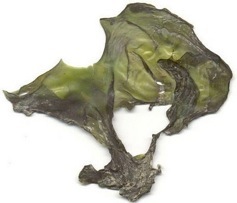
Is Nostoc a no-no? Photo by Green Deane
Nostoc: Nasal Nostalgia and Edible, Too
My website is “Eat The Weeds and other things, too.” Well, this one of those other things. While I have put seaweed in the mainstream index, I thought best to put Nostoc in the “other edibles” index. Green slime shaped like marbles takes a little getting used to. (Read the concerns in the comments below the article)
Nostoc is a freshwater bacterium in the Blue-Green family. This is important: NEVER eat any alga that is blueish-green in color. It can kill you. Nostoc is bright green, despite the family association. If you visually have a green blue color problem, this is a family to stay away from.
 Nostoc marbles are made up of nostic filaments. The spheres are uniform size and usually green or olive green in color. Again void any blue-green ones. The filaments are long and held together by firm mucilage. They form colonies often marble size but also as big as a baseball. They can also be leaf- or hair-like. They are used like other algae or sea weed but not without some controversy.
Nostoc marbles are made up of nostic filaments. The spheres are uniform size and usually green or olive green in color. Again void any blue-green ones. The filaments are long and held together by firm mucilage. They form colonies often marble size but also as big as a baseball. They can also be leaf- or hair-like. They are used like other algae or sea weed but not without some controversy.
Nostoc has been eaten in Asia for thousands of years — is an essential ingredient in traditional bird-nest soup — but a recent study asserted it could contribute to Alzheimer’s Disease. Containing protein and vitamin C, N. flagelliforme and N. commune are eaten in China, Japan and Java, N. commune is served in the Andes. The preferred species in Central Asia is N. ellipsosporum. Dried Nostoc can be purchased in most Asian groceries, should you want a test taste run.
The aforementioned research team from the Chinese University of Hong Kong said “fat choy” (Nostoc flagelliforme) has no nutritional value and contains Beta-methylamino L-alanine (BMAA), a toxic amino acid that could affect the normal nerve cell function. Professor Chan King-ming said eating fat choy could lead to degenerative diseases such as Alzheimer’s, Parkinson’s, and dementia. A 2008 study in Peru also found BMAAS, now you have both sides of the food, eaten but potentially toxic or toxic.
While I have found Nostoc many times my main objection to it is I have not found it in wholesome water or soil. It has not so much been the Nostoc I don’t like as the environments I’ve found it in. I think mountain streams and meadows could be different. Among the known edible Nostoc are N. commune var flagelliforme, N. parmelioides (edule) N. ellipsosporum, N. verrucosum and N. pruniforme. Dehydrated Nostoc is black but it can rehydrate quickly after storms and the like and appear to have grown seemingly overnight. This made those in the Middle Age think it fell overnight from the stars or planets. It wasn’t until 1727 that it was figured out that Nostoc wasn’t extraterrestrial and showed up around the roots of grasses after a lot of rain.
 The genus name, Nostoc, was coined by “Paracelsus” which is a story unto itself. Auroleus Phillipus Theostratus Bombastus von Hohenheim, who later called himself “Paracelsus,” was born in Switzerland in 1493. He was the son of a well-known physician. Paracelsus became a physician, alchemist, professor and a heretic of much fame and controversy. He studied mineralogy, medicine, surgery, physics, astrology and chemistry, was a teacher by the time he was 16 and generally irritated the establishment with his intellect and ideas. Doctors often denounced him an impostor and his quick death in 1541 suggests someone got fed up with his arrogance and knocked him off. Controversial to say the least it was said of him he “cured the incurable, gave sight to the blind, cleansed the leper, and even raised the dead, and whose memory could turn aside the plague.” He also gave zinc its name and was the first to describe tuberculosis as a disease of the lungs. His motto was “alterius non sit qui suus esse potest” which means “let no man that can belong to himself be of another.”
The genus name, Nostoc, was coined by “Paracelsus” which is a story unto itself. Auroleus Phillipus Theostratus Bombastus von Hohenheim, who later called himself “Paracelsus,” was born in Switzerland in 1493. He was the son of a well-known physician. Paracelsus became a physician, alchemist, professor and a heretic of much fame and controversy. He studied mineralogy, medicine, surgery, physics, astrology and chemistry, was a teacher by the time he was 16 and generally irritated the establishment with his intellect and ideas. Doctors often denounced him an impostor and his quick death in 1541 suggests someone got fed up with his arrogance and knocked him off. Controversial to say the least it was said of him he “cured the incurable, gave sight to the blind, cleansed the leper, and even raised the dead, and whose memory could turn aside the plague.” He also gave zinc its name and was the first to describe tuberculosis as a disease of the lungs. His motto was “alterius non sit qui suus esse potest” which means “let no man that can belong to himself be of another.”
He is quoted as writing: “Nostoch … pollution of some plethoricall and wanton Star, or rather excrement blown from the nostrills of some rheumantick planet…. Nostoch understandeth the nocturnall.” “Nostoch” is a play on two words, one English and one German, each associated with nostril and “extracellular polysaccharide (the stuff that comes out of your nose.) Nostryle was the English contributor of NOST and Nasenloch contributed the OCH, shorten today to OC. Paracelsus likened Nostoc to nose dribble and named it accordingly. I should add if it gets too much light it can smell like ammonia. Not all are palatable. One noxious version is Pwdre Ser (yes that is spelled correctly.) It is Welsh and means “rot of the stars.” The Chinese view of Nostoc is very different.
The Chinese know (Nostoc flagelliforme) as Fat Choy, Black Moss and Black Hair. When dried, it has the appearance of black hair. Because of that its name in Chinese means “hair vegetable.” This sounds the same as a Cantonese saying meaning “struck it rich” or “Kung hei fat choi” which is often proclaimed during the Chinese New Year. So Fat Choy is a popular ingredient in dishes used for the Chinese New Year. Its texture which is like very fine vermicelli. Because over harvesting has caused erosion the Chinese government has limited collection which has increased prices. To find use look for “fat choy recipes” on the internet. See recipe below.
Green Deane’s Itemizing Plant Profile
IDENTIFICATION: A jelly like green mass , spheres from the size of marble to baseballs.
TIME OF YEAR: Any time but usually warm weather after rain
ENVIRONMENT: In fields after it rains, especially among grass, bottoms of lakes or springs, on moist rocks, rarely on ice bergs.
METHOD OF PREPARATION: Dry, them use as is or as a thickener
Oysters and Nostoc
1 Chinese lettuce
1 Iceberg lettuce
8 jumbo oysters
2 Tablespoons vegetable oil
8 black mushrooms, soaked in water
1/2 pound black hair seaweed (fat choy)
1/3 cup chicken stock
2 tablespoons oyster sauce
1 Tablespoon sesame oil
1/4 Teaspoon salt (optional to taste)
1 Teaspoon sugar
1 Teaspoon cornstarch
1 Tablespoon water
Soak the Fat Choy for a few minutes in warm water before you begin and drain on paper towels before you add to the wok. Remove enough lettuce leaves from the two kinds of lettuce to line a large serving dish. Place lettuce leaves quickly in hot seasoned water. You want to soften the lettuce and blanch it, but not cook it. Remove and line the serving dish with the leaves. Poach oysters in the same water until about halfway cooked (quick – about 30 to 45 seconds). Remove the oysters from the water. Heat a Chinese wok or large frying pan and quickly saute the oysters with vegetable oil. Stir in the black mushrooms, pre-soaked fat choy, chicken stock and oyster sauce. Cook for a few minutes until the mushrooms are soft. Season the sauce with sesame oil, salt and sugar. Thoroughly mix cornstarch and water until it forms a paste. While stirring, add the cornstarch mixture to the sauce until it become slightly thick. You may not need all of the cornstarch so add slowly. Place oysters, black mushrooms and fat choy on top of lettuce in a nice grouping. Serve and if you are preparing this for the New Year table, have a prosperous year!


This is extremely dangerous misinformation. Any cyanobacterium has the potential to produce toxic compounds and nostoc in particular has been cited in the past for producing cyanotoxic compounds in the wild (https://www.sciencedirect.com/topics/agricultural-and-biological-sciences/nostoc-muscorum). Cyanotoxins are an evolving field of study and even if you took a sample to the lab and they ruled out currently known cyanotoxins there is NO GUARANTEE as of yet undiscovered cyanotoxins aren’t still lurking within the sample. There are EIGHTY KNOWN microcystins alone (https://citeseerx.ist.psu.edu/viewdoc/download?doi=10.1.1.169.7591&rep=rep1&type=pdf) and likely more to be discovered.
“The fact that known toxins are usually found in new locations once people look for them, for example,
recent discoveries of CYN in New Zealand (Stirling and Quilliam 2001),
Thailand (Li et al. 2001b), Germany (Fastner et al. 2003), Brazil (Carmi-
chael et al. 2001) and Florida (Burns 2005), suggests that the toxigenic
species are widespread and that no country should consider itself immune from the risk to public health even from the known toxins. A further point
that needs reinforcing is that single microcystins or single cylindrosper-
mopsins almost never occur in nature. Instead mixtures of toxins are the
norm, and so we need to understand toxin interactions. This will enable the
calibration of studies done using MC-LR and the formulation of regula-
tions to be based on toxicity equivalents rather than quantities of individual
compound”
In addition n. commune is a FORM SPECIES (https://pubmed.ncbi.nlm.nih.gov/11594617/), not an exact one. It is very likely numerous distinct species of nostoc that happen to share similar growth modes across multiple environments. Even trained professionals would have extreme difficulty giving an exact identification beyond the form – what chance do you have? N. commune is not a plant, it’s not a mushroom. It is a gelatinous colony of unicellular cyanobacteria living in a microbial mat environment that could attract god knows what other species of microbiota that could produce god knows what other types of toxin you would never know about until it’s too late. It’s the equivalent of willfully ingesting stagnant swamp water. Russian roulette via forage.
Don’t put it in your mouth, and to anybody reading this, don’t listen to this article. You are gambling with your future health and well being. Many deleterious health outcomes have been reported from peoples who ingest, knowingly or unknowingly, cyanobacterial sp. You have no way of knowing what you’re eating and no way of guaranteeing a sample free from toxins, known or unknown. This is not like plant identification, it’s not even like mushroom identification – no amount of hands-on experience is going to make the risks associated with cyanotoxins safer for you. Only a team of trained scientists and extremely expensive tools can narrow that risk (and even then, not eliminate it entirely). Even algal and cyanobacteria supplements on the store shelves have had issues guaranteeing quality control in this matter (https://www.ncbi.nlm.nih.gov/pmc/articles/PMC5371831/).
Use your brain. Never put anything into your mouth you can’t ID with 100% certainty.